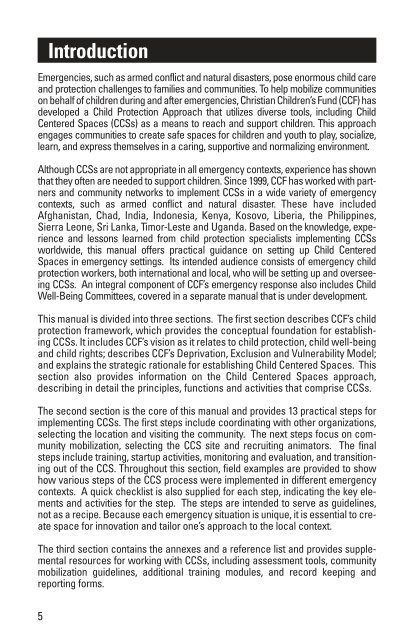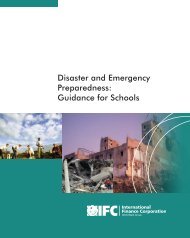Starting Up Child Centered Spaces in Emergencies: A Field Manual
Starting Up Child Centered Spaces in Emergencies: A Field Manual
Starting Up Child Centered Spaces in Emergencies: A Field Manual
- No tags were found...
You also want an ePaper? Increase the reach of your titles
YUMPU automatically turns print PDFs into web optimized ePapers that Google loves.
Introduction<strong>Emergencies</strong>, such as armed conflict and natural disasters, pose enormous child careand protection challenges to families and communities. To help mobilize communitieson behalf of children dur<strong>in</strong>g and after emergencies, Christian <strong>Child</strong>ren’s Fund (CCF) hasdeveloped a <strong>Child</strong> Protection Approach that utilizes diverse tools, <strong>in</strong>clud<strong>in</strong>g <strong>Child</strong><strong>Centered</strong> <strong>Spaces</strong> (CCSs) as a means to reach and support children. This approachengages communities to create safe spaces for children and youth to play, socialize,learn, and express themselves <strong>in</strong> a car<strong>in</strong>g, supportive and normaliz<strong>in</strong>g environment.Although CCSs are not appropriate <strong>in</strong> all emergency contexts, experience has shownthat they often are needed to support children. S<strong>in</strong>ce 1999, CCF has worked with partnersand community networks to implement CCSs <strong>in</strong> a wide variety of emergencycontexts, such as armed conflict and natural disaster. These have <strong>in</strong>cludedAfghanistan, Chad, India, Indonesia, Kenya, Kosovo, Liberia, the Philipp<strong>in</strong>es,Sierra Leone, Sri Lanka, Timor-Leste and Uganda. Based on the knowledge, experienceand lessons learned from child protection specialists implement<strong>in</strong>g CCSsworldwide, this manual offers practical guidance on sett<strong>in</strong>g up <strong>Child</strong> <strong>Centered</strong><strong>Spaces</strong> <strong>in</strong> emergency sett<strong>in</strong>gs. Its <strong>in</strong>tended audience consists of emergency childprotection workers, both <strong>in</strong>ternational and local, who will be sett<strong>in</strong>g up and oversee<strong>in</strong>gCCSs. An <strong>in</strong>tegral component of CCF’s emergency response also <strong>in</strong>cludes <strong>Child</strong>Well-Be<strong>in</strong>g Committees, covered <strong>in</strong> a separate manual that is under development.This manual is divided <strong>in</strong>to three sections. The first section describes CCF’s childprotection framework, which provides the conceptual foundation for establish<strong>in</strong>gCCSs. It <strong>in</strong>cludes CCF’s vision as it relates to child protection, child well-be<strong>in</strong>gand child rights; describes CCF’s Deprivation, Exclusion and Vulnerability Model;and expla<strong>in</strong>s the strategic rationale for establish<strong>in</strong>g <strong>Child</strong> <strong>Centered</strong> <strong>Spaces</strong>. Thissection also provides <strong>in</strong>formation on the <strong>Child</strong> <strong>Centered</strong> <strong>Spaces</strong> approach,describ<strong>in</strong>g <strong>in</strong> detail the pr<strong>in</strong>ciples, functions and activities that comprise CCSs.The second section is the core of this manual and provides 13 practical steps forimplement<strong>in</strong>g CCSs. The first steps <strong>in</strong>clude coord<strong>in</strong>at<strong>in</strong>g with other organizations,select<strong>in</strong>g the location and visit<strong>in</strong>g the community. The next steps focus on communitymobilization, select<strong>in</strong>g the CCS site and recruit<strong>in</strong>g animators. The f<strong>in</strong>alsteps <strong>in</strong>clude tra<strong>in</strong><strong>in</strong>g, startup activities, monitor<strong>in</strong>g and evaluation, and transition<strong>in</strong>gout of the CCS. Throughout this section, field examples are provided to showhow various steps of the CCS process were implemented <strong>in</strong> different emergencycontexts. A quick checklist is also supplied for each step, <strong>in</strong>dicat<strong>in</strong>g the key elementsand activities for the step. The steps are <strong>in</strong>tended to serve as guidel<strong>in</strong>es,not as a recipe. Because each emergency situation is unique, it is essential to createspace for <strong>in</strong>novation and tailor one’s approach to the local context.The third section conta<strong>in</strong>s the annexes and a reference list and provides supplementalresources for work<strong>in</strong>g with CCSs, <strong>in</strong>clud<strong>in</strong>g assessment tools, communitymobilization guidel<strong>in</strong>es, additional tra<strong>in</strong><strong>in</strong>g modules, and record keep<strong>in</strong>g andreport<strong>in</strong>g forms.5
















